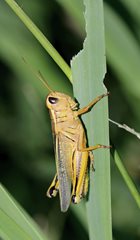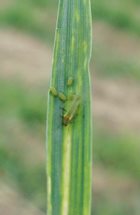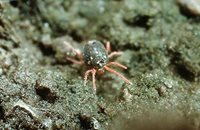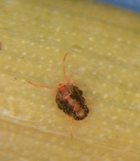Controlling Insects in Newly Seeded Winter Wheat

Remove wheat curl mite host plants
Microscopic wheat curl mites, which survive on some annual grasses, volunteer wheat, sorghum and corn, can infect your crop with wheat streak mosaic virus if not eliminated before your stand emerges. This disease can cause severe yield losses if it infects a winter wheat crop in the fall.Insecticides aren’t effective on this tiny pest, but you can mitigate it by targeting its food source. Wheat curl mites can only survive 10 days without green leaf tissue, so a burndown application made at least 14 days before seeding winter wheat helps ensure existing mites won’t live long enough to infect the crop.
Use insecticide seed treatments
Another step in controlling insects that occur prior to planting is selecting the right seed treatment for your acres. If you take a crop production minded approach with your wheat and manage it like corn, arming your CROPLAN® wheat seed with an insecticide and fungicide treatment is essential. This is especially the case in fields with substantial insect history and no-till acres where higher insect and disease pressure is of particular concern.We offer four seed treatment options designed to decrease seeding rates by helping to improve seedling establishment and minimize the losses in yield and quality, three of which include an insecticide treatment:
- Warden® Cereals II: a combination of three fungicides.
- Warden Cereals HR: a high-rate insecticide for Hessian fly and aphids plus two fungicides.
- Warden Cereals WRII: four fungicides and a high-rate insecticide for enhanced wireworm control.
Scout and protect your crop in season
Several different types of insects are looking to take a bite out of your winter wheat crop every season, so it’s important to diligently scout your fields and apply insecticides when necessary.Top pests to be wary of:

Grasshoppers living off the lush food source provided by nearby fields could be a threat to your winter wheat crop when it’s emerging, especially if temperatures are warm this fall. Three or more grasshoppers per square yard within a field can destroy seedling wheat1, so be sure to continue scouting your alfalfa crop if positioned near wheat and spray when necessary. An application of Grizzly® Too insecticide can help hinder their movement to wheat.

Aphids not only feed on wheat, but they can also transmit Barley Yellow Dwarf virus. More than 20 different aphid species can carry the disease2, so consider your area’s history and be diligent in your scouting efforts. A well-timed application of Grizzly Too or Yuma® 4E insecticide can help suppress aphid pressure.

Winter grain mite populations peak around October and March, and sandy, coarse fields are more at risk. A crop will have a stunted, silver-gray appearance from the road when there is significant pressure. Malathion 5 insecticide can provide good control.

Brown wheat mites are most active in late fall and early spring. They cause stippling of the leaves by piercing plant cells and give the crop a scorched and weathered appearance from a distance. An application of Yuma or Dimate 4E insecticide can help curb this pest.

Armyworms tend to be more of a problem in the spring, but populations can multiply in the fall under warm conditions. These crawlers eat fast and move fast. In fact, one larva can eat about 43 linear inches of plant tissue with 75% of that in a three- to four-day period. For that reason, you need to spray for them as soon as they show up in your fields. Grizzly Too or Yuma insecticide treatments can be effective in reducing armyworm populations.
Your best line of defense against insects is to proactively seek them out and be prepared to spray for them when necessary. So, in addition to regularly scouting your fields for pests, be sure to talk with your locally owned and operated WinField United retailer and fellow farmers in your area to learn if others are experiencing heavy insect pressure. If they are, it’s likely only a matter of time before populations show up in your fields.1 “Wheat Insect Management”, www.bookstore.ksre.ksu.edu/pubs/mf745.pdf
2 “Barley Yellow Dwarf”, www.cropwatch.unl.edu/plantdisease/wheat/barley-yellow-dwarf
This article was originally published in July 2020 and was updated in July 2021.
All photos are either the property of WinField United or used with permission.
© 2021 WinField United. Important: Before use always read and follow label instructions. Crop performance is dependent on several factors many of which are beyond the control of WinField United, including without limitation, soil type, pest pressures, agronomic practices and weather conditions. Growers are encouraged to consider data from multiple locations, over multiple years and to be mindful of how such agronomic conditions could impact results. Ascend®, CROPLAN®, Grizzly®, Warden®, WinField® and Yuma® are trademarks of WinField United. All other trademarks are the property of their respective owners.

